独立主格结构和 with without复合结构
- 格式:ppt
- 大小:372.50 KB
- 文档页数:19
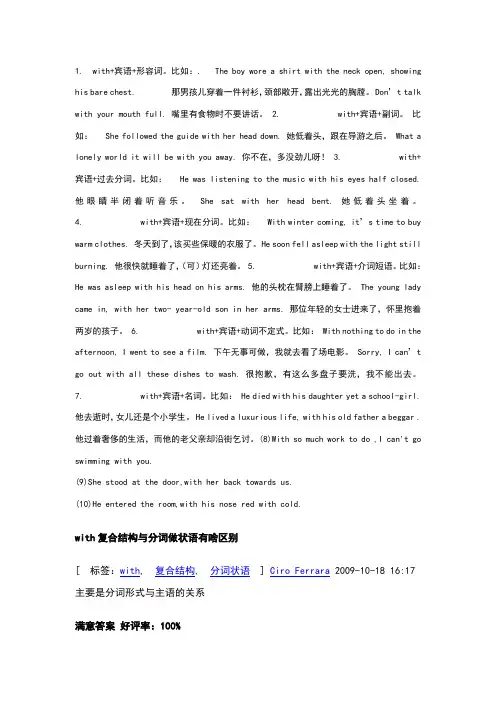
1. with+宾语+形容词。
比如:. The boy wore a shirt with the neck open, showing his bare chest. 那男孩儿穿着一件衬衫,颈部敞开,露出光光的胸膛。
Don’t talk with your mouth full. 嘴里有食物时不要讲话。
2. with+宾语+副词。
比如:She followed the guide with her head down. 她低着头,跟在导游之后。
What a lonely world it will be with you away. 你不在,多没劲儿呀!3. with+宾语+过去分词。
比如:He was listening to the music with his eyes half closed. 他眼睛半闭着听音乐。
She sat with her head bent. 她低着头坐着。
4. with+宾语+现在分词。
比如:With winter coming, it’s time to buy warm clothes. 冬天到了,该买些保暖的衣服了。
He soon fell asleep with the light still burning. 他很快就睡着了,(可)灯还亮着。
5. with+宾语+介词短语。
比如:He was asleep with his head on his arms. 他的头枕在臂膀上睡着了。
The young lady came in, with her two- year-old son in her arms. 那位年轻的女士进来了,怀里抱着两岁的孩子。
6. with+宾语+动词不定式。
比如: With nothing to do in the afternoon, I went to see a film. 下午无事可做,我就去看了场电影。
Sorry, I can’t go out with all these dishes to wash. 很抱歉,有这么多盘子要洗,我不能出去。
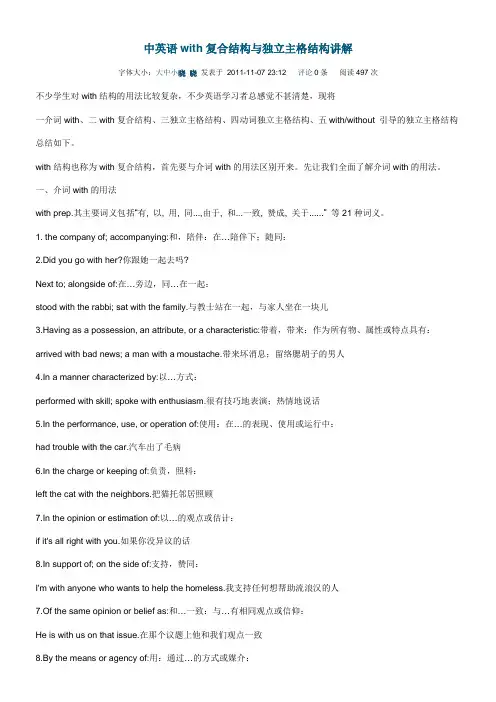
中英语with复合结构与独立主格结构讲解字体大小:大中小晓晓发表于2011-11-07 23:12评论0条阅读497次不少学生对with结构的用法比较复杂,不少英语学习者总感觉不甚清楚,现将一介词with、二with复合结构、三独立主格结构、四动词独立主格结构、五with/without 引导的独立主格结构总结如下。
with结构也称为with复合结构,首先要与介词with的用法区别开来。
先让我们全面了解介词with的用法。
一、介词with的用法with prep.其主要词义包括“有, 以, 用, 同...,由于, 和...一致, 赞成, 关于......” 等21种词义。
1. the company of; accompanying:和,陪伴:在…陪伴下;随同:2.Did you go with her?你跟她一起去吗?Next to; alongside of:在…旁边,同…在一起:stood with the rabbi; sat with the family.与教士站在一起,与家人坐在一块儿3.Having as a possession, an attribute, or a characteristic:带着,带来:作为所有物、属性或特点具有:arrived with bad news; a man with a moustache.带来坏消息;留络腮胡子的男人4.In a manner characterized by:以…方式:performed with skill; spoke with enthusiasm.很有技巧地表演;热情地说话5.In the performance, use, or operation of:使用:在…的表现、使用或运行中:had trouble with the car.汽车出了毛病6.In the charge or keeping of:负责,照料:left the cat with the neighbors.把猫托邻居照顾7.In the opinion or estimation of:以…的观点或估计:if it's all right with you.如果你没异议的话8.In support of; on the side of:支持,赞同:I'm with anyone who wants to help the homeless.我支持任何想帮助流浪汉的人7.Of the same opinion or belief as:和…一致:与…有相同观点或信仰:He is with us on that issue.在那个议题上他和我们观点一致8.By the means or agency of:用:通过…的方式或媒介:eat with a fork; made us laugh with his jokes.用叉子吃饭;以他的笑话引我们发笑9. In spite of:尽管:With all her experience, she could not get a job.尽管很有经验,她还是找不到工作10. In the same direction as:与…同向:sail with the wind; flow with the river.顺风起帆;顺河而流11. At the same time as:与…同时:gets up with the birds.与鸟儿同时起床12. In regard to:关于,对于:We are pleased with her decision. They are disgusted with the situations.她这样决定,我们很高兴;他们对现状很厌恶13. Used as a function word to indicate a party to an action, a communicative activity, or an informal agreement or settlement:和…:用作功能词表示某个动作、交流活动或非正式协议或决定的一方:played with the dog; had a talk with the class; lives with an aunt.与狗玩;和班上的同学谈一谈;与姑母住在一起14. In comparison or contrast to:与…相比;与…对照:a dress identical with the one her sister just bought.和她姐姐刚买衣服同一款式15. Having received:收到,获得:With her permission, he left. I escaped with just a few bruises.获得她允许后,他离开了。
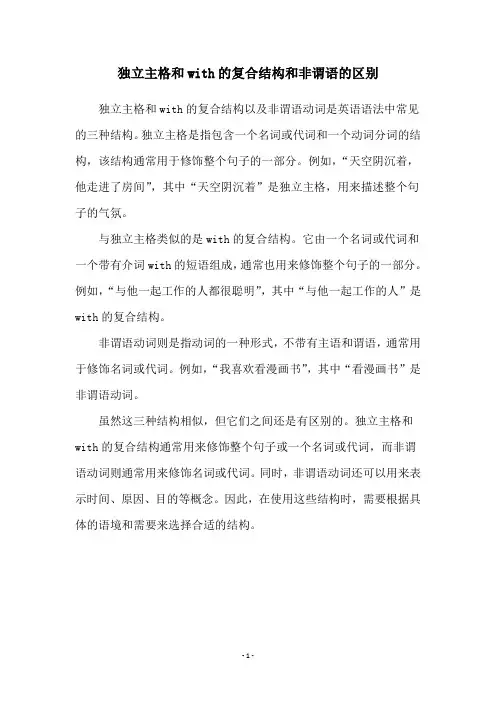
独立主格和with的复合结构和非谓语的区别独立主格和with的复合结构以及非谓语动词是英语语法中常见的三种结构。
独立主格是指包含一个名词或代词和一个动词分词的结构,该结构通常用于修饰整个句子的一部分。
例如,“天空阴沉着,他走进了房间”,其中“天空阴沉着”是独立主格,用来描述整个句子的气氛。
与独立主格类似的是with的复合结构。
它由一个名词或代词和一个带有介词with的短语组成,通常也用来修饰整个句子的一部分。
例如,“与他一起工作的人都很聪明”,其中“与他一起工作的人”是with的复合结构。
非谓语动词则是指动词的一种形式,不带有主语和谓语,通常用于修饰名词或代词。
例如,“我喜欢看漫画书”,其中“看漫画书”是非谓语动词。
虽然这三种结构相似,但它们之间还是有区别的。
独立主格和with的复合结构通常用来修饰整个句子或一个名词或代词,而非谓语动词则通常用来修饰名词或代词。
同时,非谓语动词还可以用来表示时间、原因、目的等概念。
因此,在使用这些结构时,需要根据具体的语境和需要来选择合适的结构。
- 1 -。
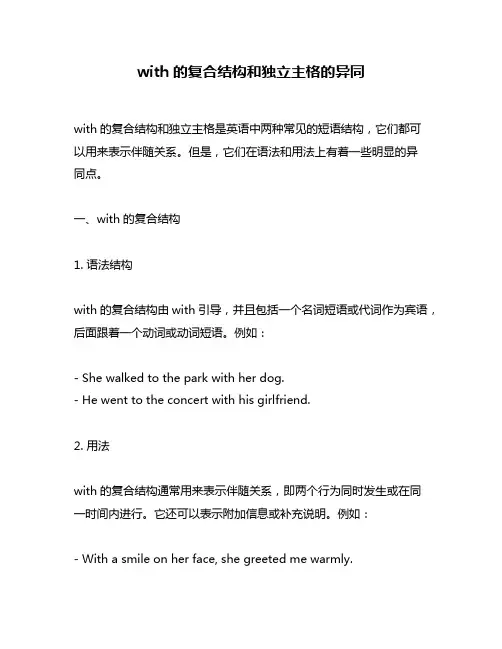
with的复合结构和独立主格的异同with的复合结构和独立主格是英语中两种常见的短语结构,它们都可以用来表示伴随关系。
但是,它们在语法和用法上有着一些明显的异同点。
一、with的复合结构1. 语法结构with的复合结构由with引导,并且包括一个名词短语或代词作为宾语,后面跟着一个动词或动词短语。
例如:- She walked to the park with her dog.- He went to the concert with his girlfriend.2. 用法with的复合结构通常用来表示伴随关系,即两个行为同时发生或在同一时间内进行。
它还可以表示附加信息或补充说明。
例如:- With a smile on her face, she greeted me warmly.- He left the party early with a headache.二、独立主格1. 语法结构独立主格是指一个名词短语或代词加上一个动名词,它们之间没有任何连接词。
例如:- The sun having set, we made our way back home.- Me being sick, I couldn't go to work today.2. 用法独立主格也表示伴随关系,但它更侧重于描述先决条件或原因。
通常情况下,独立主格放在句子的开头,用逗号与主句分开。
例如:- The weather being nice, we decided to have a picnic.- Her parents having died, she was left alone in the world.三、异同点1. 语法结构with的复合结构和独立主格在语法结构上有很大的差别。
前者是一个介词短语加上一个宾语和动词,后者则是一个名词短语或代词加上一个动名词。
2. 用法虽然两种结构都可以表示伴随关系,但是它们在用法上有一些不同。
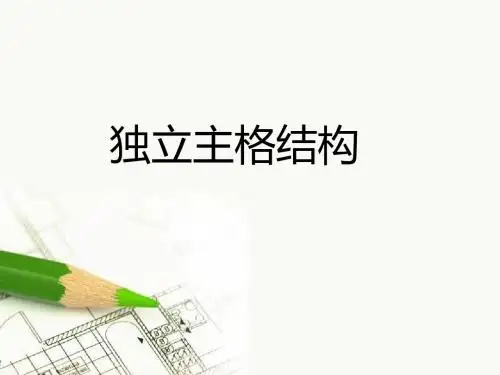
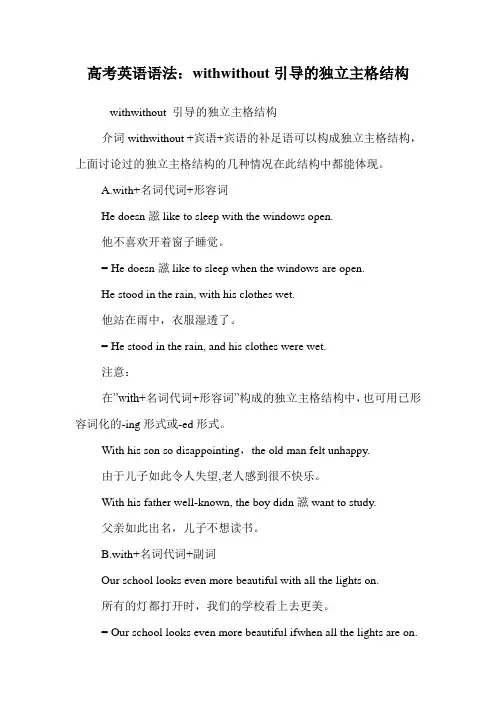
高考英语语法:withwithout引导的独立主格结构withwithout 引导的独立主格结构介词withwithout +宾语+宾语的补足语可以构成独立主格结构,上面讨论过的独立主格结构的几种情况在此结构中都能体现。
A.with+名词代词+形容词He doesn誸like to sleep with the windows open.他不喜欢开着窗子睡觉。
= He doesn誸like to sleep when the windows are open.He stood in the rain, with his clothes wet.他站在雨中,衣服湿透了。
= He stood in the rain, and his clothes were wet.注意:在”with+名词代词+形容词”构成的独立主格结构中,也可用已形容词化的-ing形式或-ed形式。
With his son so disappointing,the old man felt unhappy.由于儿子如此令人失望,老人感到很不快乐。
With his father well-known, the boy didn誸want to study.父亲如此出名,儿子不想读书。
B.with+名词代词+副词Our school looks even more beautiful with all the lights on.所有的灯都打开时,我们的学校看上去更美。
= Our school looks even more beautiful ifwhen all the lights are on.The boy was walking, with his father ahead.父亲在前,小孩在后走着。
= The boy was walking and his father was ahead.C.with+名词代词+介词短语He stood at the door, with a computer in his hand.或He stood at the door, computer in hand.他站在门口,手里拿着一部电脑。
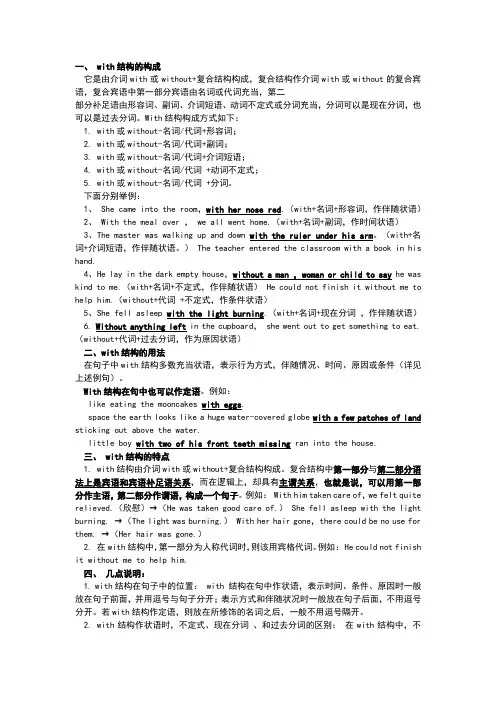
一、 with结构的构成它是由介词with或without+复合结构构成,复合结构作介词with或without的复合宾语,复合宾语中第一部分宾语由名词或代词充当,第二部分补足语由形容词、副词、介词短语、动词不定式或分词充当,分词可以是现在分词,也可以是过去分词。
With结构构成方式如下:1. with或without-名词/代词+形容词;2. with或without-名词/代词+副词;3. with或without-名词/代词+介词短语;4. with或without-名词/代词 +动词不定式;5. with或without-名词/代词 +分词。
下面分别举例:1、 She came into the room,with her nose red.(with+名词+形容词,作伴随状语)2、 With the meal over , we all went home.(with+名词+副词,作时间状语)3、The master was walking up and down with the ruler under his arm。
(with+名词+介词短语,作伴随状语。
) The teacher entered the classroom with a book in his hand.4、He lay in the dark empty house,without a man ,woman or child to say he was kind to me.(with+名词+不定式,作伴随状语) He could not finish it without me to help him.(without+代词 +不定式,作条件状语)5、She fell asleep with the light burning.(with+名词+现在分词,作伴随状语)6. Without anything left in the cupboard, she went out to get something to eat.(without+代词+过去分词,作为原因状语)二、with结构的用法在句子中with结构多数充当状语,表示行为方式,伴随情况、时间、原因或条件(详见上述例句)。
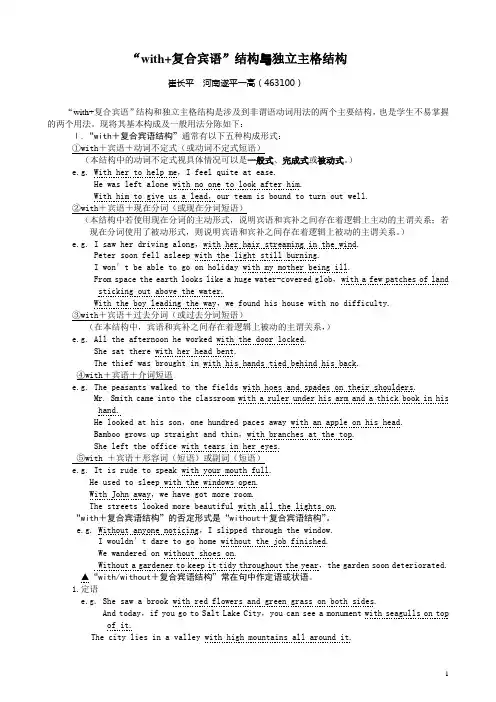
“with+复合宾语”结构与独立主格结构崔长平河南遂平一高(463100)“with+复合宾语”结构和独立主格结构是涉及到非谓语动词用法的两个主要结构,也是学生不易掌握的两个用法。
现将其基本构成及一般用法分陈如下:Ⅰ.“with+复合宾语结构”通常有以下五种构成形式:①with+宾语+动词不定式(或动词不定式短语)(本结构中的动词不定式视具体情况可以是一般式、完成式或被动式。
)e.g. With her to help me,I feel quite at ease.He was left alone with no one to look after him.With him to give us a lead,our team is bound to turn out well.②with+宾语+现在分词(或现在分词短语)(本结构中若使用现在分词的主动形式,说明宾语和宾补之间存在着逻辑上主动的主谓关系;若现在分词使用了被动形式,则说明宾语和宾补之间存在着逻辑上被动的主谓关系。
)e.g. I saw her driving along,with her hair streaming in the wind.Peter soon fell asleep with the light still burning.I won′t be able to go on holiday with my mother being ill.From space the earth looks like a huge water-covered glob,with a few patches of land sticking out above the water.With the boy leading the way,we found his house with no difficulty.③with+宾语+过去分词(或过去分词短语)(在本结构中,宾语和宾补之间存在着逻辑上被动的主谓关系,)e.g. All the afternoon he worked with the door locked.She sat there with her head bent.The thief was brought in with his hands tied behind his back.④with+宾语+介词短语e.g. The peasants walked to the fields with hoes and spades on their shoulders.Mr. Smith came into the classroom with a ruler under his arm and a thick book in his hand.He looked at his son,one hundred paces away with an apple on his head.Bamboo grows up straight and thin,with branches at the top.She left the office with tears in her eyes.⑤with +宾语+形容词(短语)或副词(短语)e.g. It is rude to speak with your mouth full.He used to sleep with the windows open.With John away,we have got more room.The streets looked more beautiful with all the lights on.“with+复合宾语结构”的否定形式是“without+复合宾语结构”。
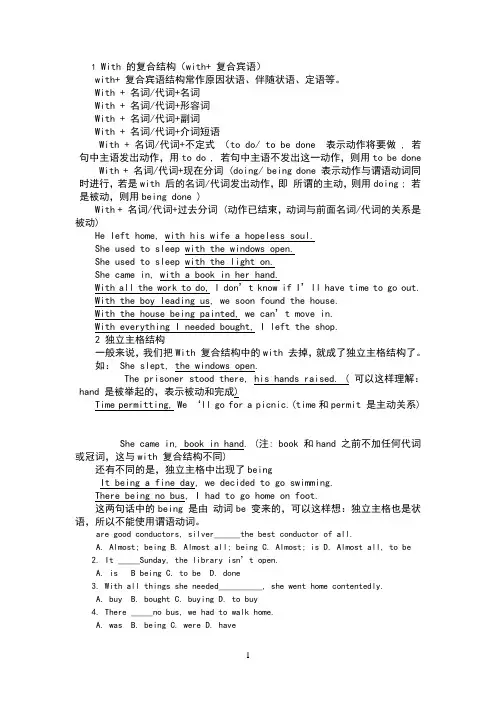
1 With 的复合结构(with+ 复合宾语)with+ 复合宾语结构常作原因状语、伴随状语、定语等。
With + 名词/代词+名词With + 名词/代词+形容词With + 名词/代词+副词With + 名词/代词+介词短语With + 名词/代词+不定式(to do/ to be done 表示动作将要做 , 若句中主语发出动作,用to do , 若句中主语不发出这一动作,则用to be done With + 名词/代词+现在分词 (doing/ being done 表示动作与谓语动词同时进行,若是with 后的名词/代词发出动作,即所谓的主动,则用doing ; 若是被动,则用being done )With + 名词/代词+过去分词 (动作已结束,动词与前面名词/代词的关系是被动)He left home, with his wife a hopeless soul.She used to sleep with the windows open.She used to sleep with the light on.She came in, with a book in her hand.With all the work to do, I don’t know if I’ll have time to go out.With the boy leading us, we soon found the house.With the house being painted, we can’t move in.With everything I needed bought, I left the shop.2 独立主格结构一般来说,我们把With 复合结构中的with 去掉,就成了独立主格结构了。
如: She slept, the windows open.The prisoner stood there, his hands raised. ( 可以这样理解:hand 是被举起的,表示被动和完成)Time permitting, We ‘ll go for a picnic.(time和permit 是主动关系)She came in, book in hand. (注: book 和hand 之前不加任何代词或冠词,这与with 复合结构不同)还有不同的是,独立主格中出现了beingIt being a fine day, we decided to go swimming.There being no bus, I had to go home on foot.这两句话中的being 是由动词be 变来的,可以这样想:独立主格也是状语,所以不能使用谓语动词。

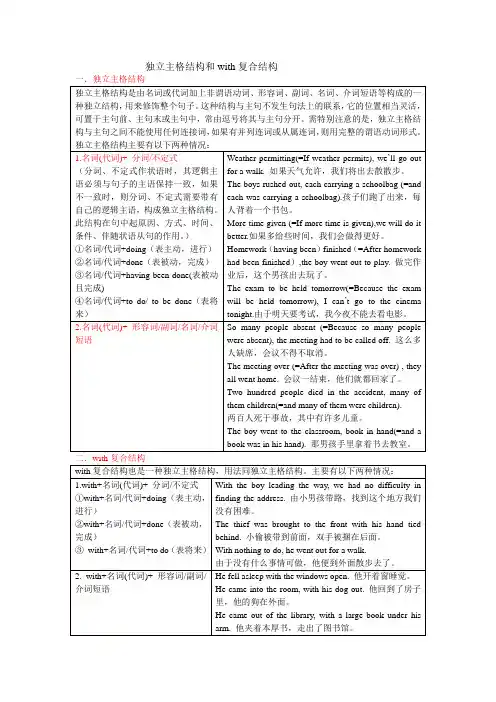
一:With复合结构与独立主格结构with复合结构与独立主格结构是英语中常见的两种结构形式。
从某种意义上说,它们可以算作是非谓语动词用法的延伸。
它们都可以在句中作原因状语、伴随状况状语、条件状语、时间状语或结果状语用,一般也可以相互转换。
虽然它们的语法功能和意义相同,但其结构形式和名称却不相同。
抓住这一点,就可以把二者融会贯通,从而在阅读中减少不必要的理解障碍。
with复合结构的模式是:with+名词/代词(作逻辑主语)+分词/形容词/副词/不定式/介词短语(作逻辑谓语)独立主格结构的模式是:主格名词/代词(作逻辑主语)+分词/形容词/副词/不定式/介词短语(作逻辑谓语)请看下例:一、作时间状语1、With winter coming on, the trees turn yellow and some birds fly south.=Winter coming on, the trees turn yellow and some birds fly south.2、With our work having been finished well, we went out for a holiday.=Our work having been finished well, we went out for a holiday. 3、With the traffic light green, the bus got moving.=The traffic light green, the bus got moving.4、With the wedding dinner party(being) over, we left the hotel.=The wedding dinner party(being) over, we left the hotel.二、作原因状语5、With it being Sunday, the library was closed.=It being Sunday, the library was closed.6、With the weather terribly cold, we entered the room to warm ourselves.=The weather terribly cold, we entered the room to warm ourselves. 7、With us to care for the children you are able to be carefree away from home.=We to care for the children, you are able to be carefree away from home.(注意此处的we 不得改成us,用了us便不是独立主格结构了。
1 With 的复合结构(with+ 复合宾语)with+ 复合宾语结构常作原因状语、伴随状语、定语等。
With + 名词/代词+名词With + 名词/代词+形容词With + 名词/代词+副词With + 名词/代词+介词短语With + 名词/代词+不定式(to do/ to be done 表示动作将要做, 若句中主语发出动作,用to do , 若句中主语不发出这一动作,则用to be doneWith + 名词/代词+现在分词(doing/ being done 表示动作与谓语动词同时进行,若是with 后的名词/代词发出动作,即所谓的主动,则用doing ; 若是被动,则用being done )With + 名词/代词+过去分词(动作已结束,动词与前面名词/代词的关系是被动) He left home, with his wife a hopeless soul.She used to sleep with the windows open.She used to sleep with the light on.She came in, with a book in her hand.With all the work to do, I don’t know if I’ll have time to go out.With the boy leading us, we soon found the house.With the house being painted, we can’t move in.With everything I needed bought, I left the shop.2 独立主格结构一般来说,我们把With 复合结构中的with 去掉,就成了独立主格结构了。
如:She slept, the windows open.The prisoner stood there, his hands raised. ( 可以这样理解:hand 是被举起的,表示被动和完成)Time permitting, We ‘ll go for a picnic.(time和permit 是主动关系)She came in, book in hand. (注: book 和hand 之前不加任何代词或冠词,这与with 复合结构不同)还有不同的是,独立主格中出现了beingIt being a fine day, we decided to go swimming.There being no bus, I had to go home on foot.这两句话中的being 是由动词be 变来的,可以这样想:独立主格也是状语,所以不能使用谓语动词。
一、with结构的构成它是由介词with或without+复合结构构成,复合结构作介词with或without的复合宾语,复合宾语中第一部分宾语由名词或代词充当,第二部分补足语由形容词、副词、介词短语、动词不定式或分词充当,分词可以是现在分词,也可以是过去分词。
With结构构成方式如下:1. with或without-名词/代词+形容词;2. with或without-名词/代词+副词;3. with或without-名词/代词+介词短语;4. with或without-名词/代词+动词不定式;5. with或without-名词/代词+分词。
下面分别举例:1、She came into the room,with her nose red.(with+名词+形容词,作伴随状语)2、With the meal over ,we all went home.(with+名词+副词,作时间状语)3、The master was walking up and down with the ruler under his arm。
(with+名词+介词短语,作伴随状语。
)The teacher entered the classroom with a book in his hand.4、He lay in the dark empty house,without a man ,woman or child to say he was kind to me.(with+名词+不定式,作伴随状语)He could not finish it without me to help him.(without+代词+不定式,作条件状语)5、She fell asleep with the light burning.(with+名词+现在分词,作伴随状语)6. Without anything left in the cupboard,she went out to get something to eat.(without+代词+过去分词,作为原因状语)二、with结构的用法在句子中with结构多数充当状语,表示行为方式,伴随情况、时间、原因或条件(详见上述例句)。